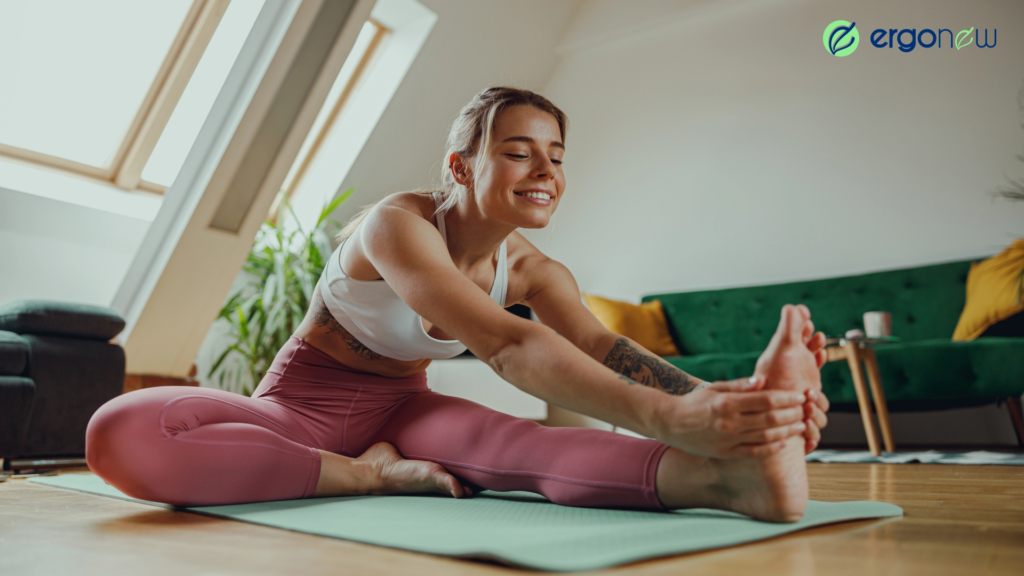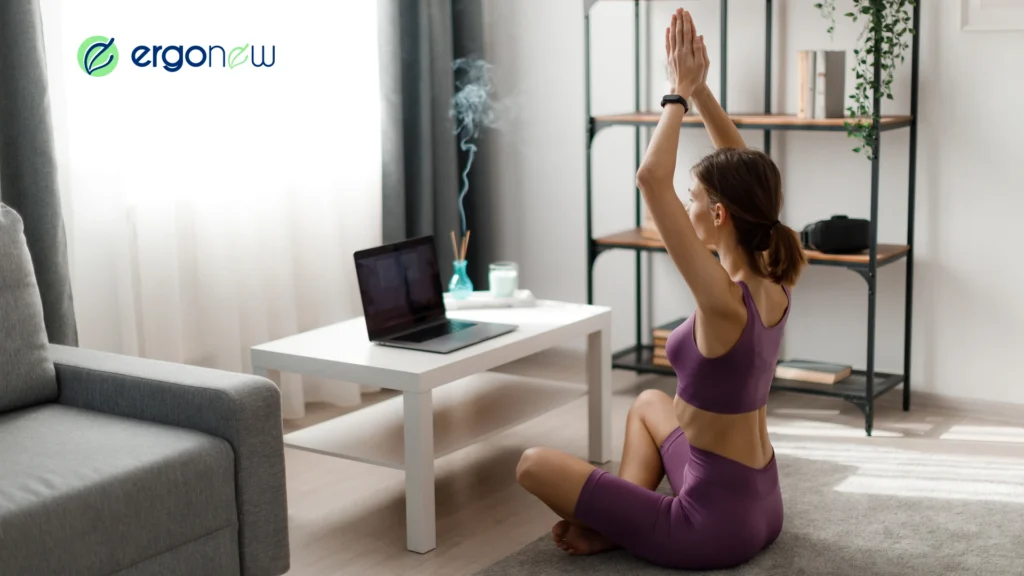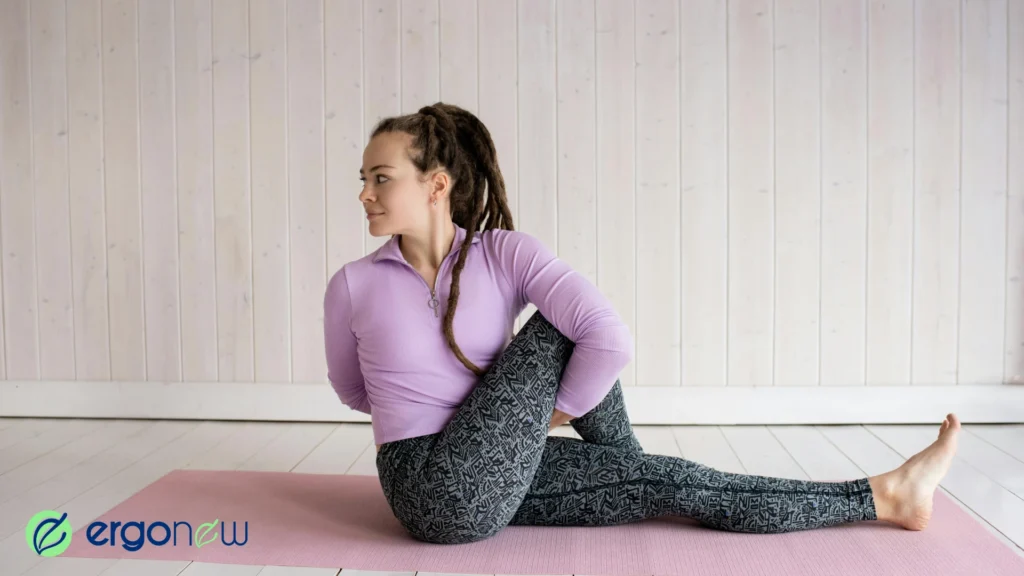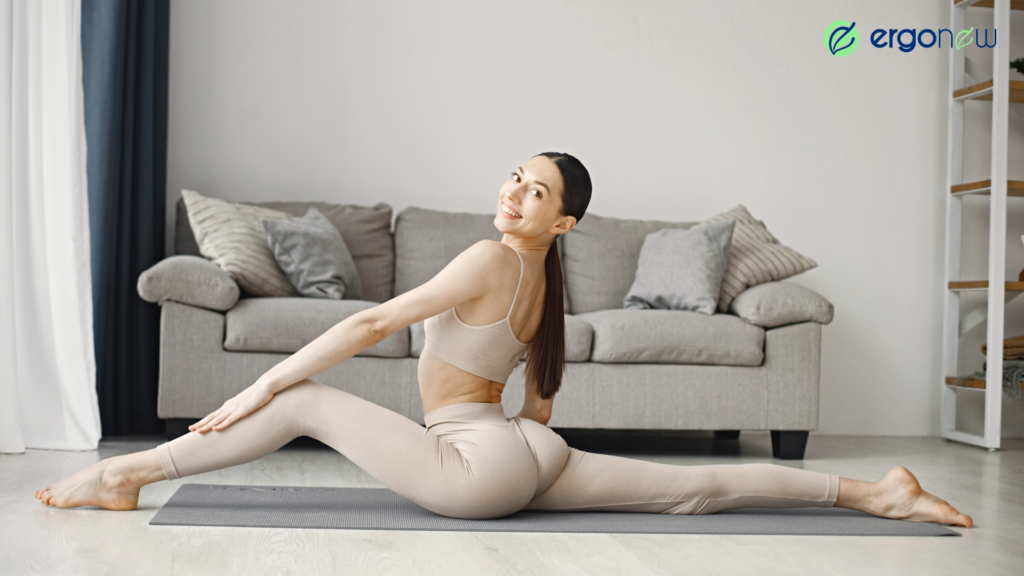Working from home has many benefits. However, it also comes with a major challenge: the lack of movement and poor posture habits. Spending hours in front of a screen can lead to back pain, wrist strain, neck stiffness, and even long-term health issues. The good news is that a structured ergonomic stretching routine can help you counteract these negative effects, improving both your comfort and productivity.
In this article, we’ll explore why stretching is essential for remote workers. We’ll also discuss the best stretches for posture correction and how to integrate them into your daily routine. Finally, we’ll cover how to optimize your workspace for long-term well-being.

Why Stretching Matters for Remote Workers
Unlike in-office environments, where walking to meetings or taking breaks might be more natural, remote workers often sit for prolonged periods without realizing it. Consequently, this sedentary behavior can lead to:
- Muscle imbalances – Certain muscles become tight, while others weaken due to inactivity. As a result, maintaining a regular stretching routine can help keep muscles balanced and prevent discomfort.
- Reduced circulation – Sitting for too long slows blood flow, increasing the risk of fatigue and discomfort. Consequently, incorporating regular movement and stretching breaks can help maintain circulation and reduce these risks.
- Increased risk of pain and injury – Poor posture and repetitive movements can cause chronic pain, especially in the back, shoulders, and wrists. Therefore, incorporating regular stretching and ergonomic adjustments can help alleviate and prevent such discomfort.
A consistent stretching routine helps in several ways:
- ✔ Release muscle tension and stiffness.
- ✔ Improve circulation to keep energy levels high.
- ✔ Reduce stress and enhance focus for better productivity.
- ✔ Prevent injuries related to poor posture and repetitive strain.
Best Stretches for Posture and Pain Relief
This stretch helps relieve stiffness in the neck caused by looking down at screens. It also promotes better alignment and reduces the risk of tension headaches.
1. Neck and Shoulder Stretches
Neck Tilt Stretch
This stretch helps relieve stiffness in the neck caused by looking down at screens. Moreover, it improves neck flexibility and reduces discomfort, enhancing overall posture.
- Sit or stand with your back straight.
- Slowly tilt your head toward your right shoulder.
- Hold for 15–20 seconds, then switch sides.
- Repeat 2–3 times per side.
Shoulder Blade Squeeze
Improves posture by strengthening the muscles between your shoulder blades. Additionally, it enhances upper back stability and reduces the risk of developing hunching.
- Sit upright with feet flat on the floor.
- Squeeze your shoulder blades together, as if holding a pencil between them.
- Hold for 5 seconds, then release.
- Repeat 10 times.

2. Ergonomic Stretching Routine: Back and Spine Stretches
Seated Spinal Twist
Reduces stiffness in the lower back from prolonged sitting. Furthermore, it promotes better spinal alignment and alleviates discomfort.
- Sit on a chair with your feet flat on the floor.
- Place your right hand on your left knee and twist your torso to the left. Hold for 20 seconds.
- Then, switch sides and repeat the twist.
- Finally, repeat the stretch 2–3 times per side for maximum benefit.
Standing Forward Bend
Stretches the lower back and hamstrings, relieving tension from sitting. Additionally, it enhances flexibility and promotes better overall posture.
- Stand with feet hip-width apart.
- Bend forward at the hips, reaching toward your toes.
- Hold for 30 seconds, keeping knees slightly bent if needed.

3. Hip and Leg Stretches
Hip Flexor Stretch
Sitting tightens the hip flexors, leading to discomfort in the lower back and hips. Consequently, regular stretching can alleviate this discomfort and promote better flexibility.
- Kneel on one knee, with the other foot forward at a 90-degree angle.
- Push hips slightly forward until you feel a stretch in the front of the hip.
- Hold for 20 seconds, then switch sides.
Seated Figure-4 Stretch
Helps relieve tightness in the hips and lower back. Additionally, it promotes better mobility and reduces discomfort from prolonged sitting.
- Sit on a chair and place your right ankle over your left knee. Additionally, this position helps stretch your hip muscles and can relieve tension in your lower back.
- Lean slightly forward to increase the stretch. Additionally, maintain a gentle and controlled motion to ensure you don’t strain the muscles.
- Hold for 20 seconds, then switch sides. Additionally, ensure you breathe deeply and maintain a relaxed posture to maximize the benefits of the stretch.

4. Ergonomic Stretching Routine: Wrist and Hand Stretches
Wrist Extension Stretch
Reduces wrist tension from prolonged typing and mouse use. Additionally, it helps prevent repetitive strain injuries and promotes overall hand flexibility.
- Extend one arm straight with the palm facing up.
- Use the opposite hand to gently pull the fingers back.
- Hold for 15 seconds, then switch hands.
Finger Spread Stretch
Prevents stiffness and improves flexibility in the hands. Additionally, it enhances overall hand function and reduces the risk of repetitive strain injuries.
- Spread your fingers as wide as possible.
- Hold for 5 seconds, then relax.
- Repeat 10 times.

Ergonomic Stretching Routine: Integrate It into Your Workday
A well-planned stretching routine doesn’t require a lot of time, but it should be consistent. Here’s a simple breakdown of when to stretch:
Morning Routine (Before Work Starts)
Purpose: Wake up your muscles and prepare your body for the workday.
- Neck tilt stretch – 3 reps per side
- Seated spinal twist – 2 reps per side
- Standing forward bend – Hold for 20 seconds
Midday Routine (Break or Lunch Time)
Purpose: Relieve tension from hours of sitting and boost circulation. Additionally, it helps increase energy levels and improves focus for the remainder of the day.
- Shoulder blade squeeze – 5 reps
- Seated figure-4 stretch – Hold for 20 seconds per side
- Hip flexor stretch – Hold for 20 seconds per side
Evening Routine (After Work)
Purpose: Release built-up tension and promote relaxation. Additionally, it helps improve overall well-being and prepares you for a restful evening.
- Standing forward bend – Hold for 30 seconds
- Full-body stretch (arms extended overhead, deep breathing) – 3 reps
- Wrist extension stretch – Hold for 15 seconds per hand
Even if you can’t do the full routine daily, incorporating even a few stretches can make a significant difference. Furthermore, these small efforts can greatly enhance your comfort and overall well-being.
Ergonomic Stretching Routine: Optimizing Your Home Office for Support
Along with stretching, adjusting your workspace ergonomics is essential for reducing strain and improving posture. Moreover, creating an ergonomic setup can help prevent long-term discomfort and promote overall health.
1. Adjust Your Chair and Desk
- Chair height: Feet flat on the floor, knees at 90 degrees. Additionally, this position promotes better posture and helps reduce strain on the lower back and legs.
- Desk height: Elbows should also be at 90 degrees when typing. Additionally, this position helps maintain comfort and reduces the risk of repetitive strain injuries in the arms and wrists.
2. Monitor Positioning
- Screen height: The top third of your screen should be at eye level to prevent neck strain. Additionally, this setup encourages better posture and reduces the risk of developing neck and shoulder pain.
- Screen distance: Keep it an arm’s length away. Furthermore, this distance ensures that your eyes remain comfortable and reduces the risk of eye strain.
3. Keyboard and Mouse Placement
- Wrist alignment: Keep wrists neutral to prevent carpal tunnel syndrome.
- Mouse positioning: Place it close to the keyboard to avoid overreaching.
4. Use Ergonomic Accessories
- Lumbar support: A cushion or ergonomic chair helps maintain spinal alignment. Furthermore, it provides comfort and support, reducing the risk of developing back pain.
- Standing desk: Alternating between sitting and standing reduces lower back strain. Furthermore, it promotes better circulation and can help maintain energy levels throughout the day.
- Ergonomic keyboard (Logitech Ergo K860): A curved, split keyboard design helps reduce strain on the wrists and forearms. Additionally, it promotes a more natural typing posture, which can prevent discomfort during long work hours.
- Ergonomic mouse (Logitech MX Master): The MX Master mouse features a sculpted design that supports the natural position of the hand. Furthermore, its precision and customizable buttons make it an excellent choice for improving productivity while minimizing wrist strain.
Final Thoughts
A home office setup should support your health, not harm it. By integrating a simple stretching routine and making ergonomic adjustments, you can improve posture, reduce pain, and increase productivity while working remotely. Consequently, these changes lead to a more comfortable and efficient work environment.
Take action today! Start with a few stretches per day and small workstation adjustments, and you’ll notice the long-term benefits. For more tips and advice on ergonomics, visit Ergonew – Best Blog for Ergonomic.
Would you like a complete ergonomic guide? If so, download our free booklet to optimize your workspace and stay pain-free!
